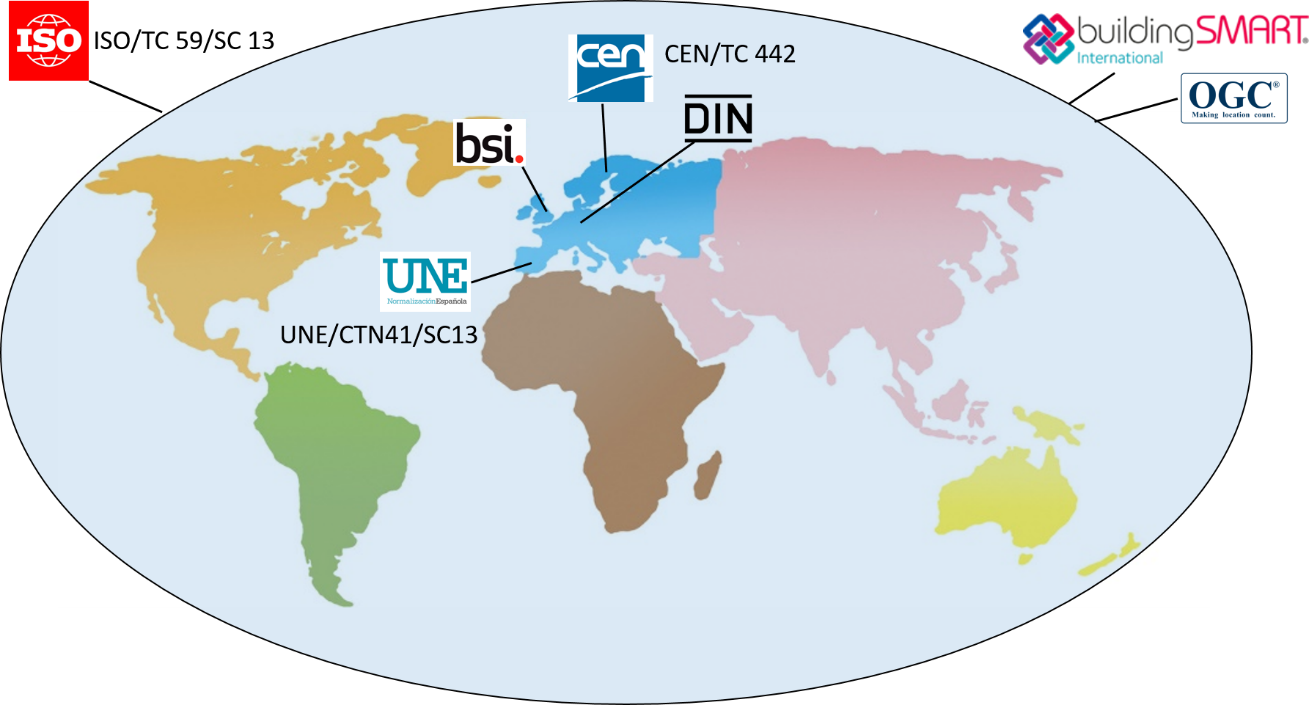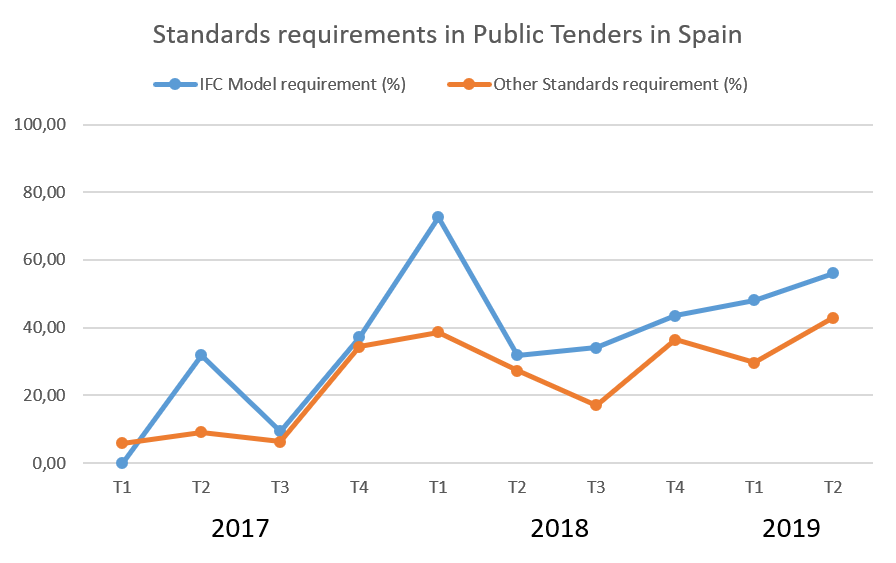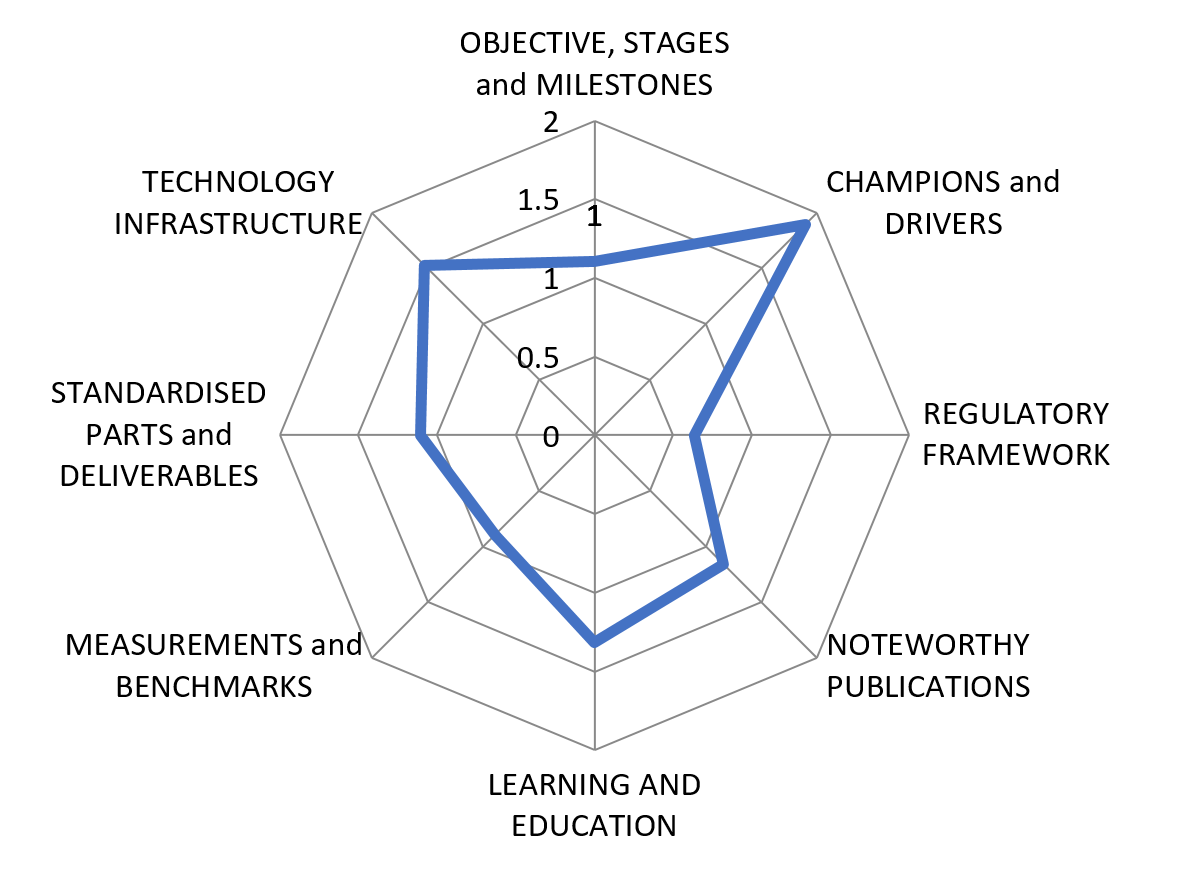Impact of BIM ISO standards in Spain

by Sergio Muñoz, buildingSMART Spain
At the end of 2018, ISO standards 19650 Parts 1 and 2, “Organization and digitization of information about buildings and civil engineering works, including building information modelling (BIM) — Information management using building information modelling”, were published. These standards were adopted and published in Europe by CEN in January 2019 and later by different countries. In Spain, these standards were published in July 2019, awakening a great interest on the sector.
Who creates BIM standards?
The purpose of standardisation is to define a set of technical specifications – STANDARDS – which are used in a voluntary way. Standards are the industry’s common language.
Standards are developed by standardisation bodies, in which a balanced representation of bodies interested in the subject participates, ensuring transparency, openness and consensus in their work. The process of elaborating a standard is open, allowing everybody to participate with their opinions or comments.
There are a several standardisation organisations, ISO and IEC at international level, CEN and CENELEC at a European level, and others at national level, such as UNE in Spain, DIN in Germany, bSI in the United Kingdom, etc.
In the specific case of BIM, standardisation is strategic in order to optimise resources and be able to have a common base between all the stakeholders involved in a project.
The productivity of the AEC industry, which accounts for around 6% of world GDP, has not advanced at the same ratios as other industrial sectors. The digitisation of construction, which relies heavily on BIM, is probably one of the main tools in the medium term to reduce its costs by between 12% and 20%[1].
In February 2018, the World Economic Forum published a report, An Action Plan to Accelerate Building Information Modelling (BIM) Adoption[2], which clearly indicates that in order to improve its productivity, the AEC industry must accelerate the BIM adoption. This same report highlights that one of the necessary pillars is to realize the benefits of digitized built environments and that governments need to coordinate with the industry to develop BIM standards, improving efficiency and interoperability.
The main standardisation bodies developing standards on BIM are:
- International level: ISO/TC 59/SC 13, Building and civil works. Organization of information on construction works.
- European level: CEN/TC 442, Building Information Modelling.
On the other hand, on a national level, there is a national BIM standardization body per country, such as UNE/CTN 41/SC 13, Organisation of information models relating to building and civil works in Spain.
Moreover, these standardization bodies work in close collaborations with some organizations, such as buildingSMART or OGC (Open Geospatial Consortium).

Brief history of the BIM standards in Spain
Although the Spanish standardization body, UNE/CT41/SC13, was created in 2011, it is in 2015, when the European CEN/TC442 was created, which arranges the adoption of the first BIM standards in Spain:
- ISO 12006-3 Building. Organization of information on construction works. Part 3: Object-oriented information framework.
- ISO 16739 IFC (Industry Foundation Classes) for the exchange of data in the construction and property management sectors.
- ISO 29481, Parts 1 and 2. Modelling of building information. Information delivery manual. Part 1: Methodology and format and Part 2: Framework for interaction.
However, it must be said that of all these standards, the only one that has had a real impact in Spain is ISO 16739 IFC, because it is being included in public tenders as a requirement. The Observatory of public tenders of esBIM analyses the public tenders with BIM requirements in Spain, publishing very interesting reports periodically. During the last 3 years, half of “BIM tenders” require the IFC model, and one third request the use of other standards (such as PAS 1192 or LOD from BIMFORUM).

It should be noted that buildingSMART Spain has carried out several activities to push this, such as the translation of the IFC elements to Spanish[3] or several workshops on how to create and read IFC models.
But as I’ve said before, the rest of the ISO BIM standards have not had any real impact. This is mainly due to the fact that these standards were mostly about communication between software (IFC), that affect the developers to meet the IFC requirements and not about the process of collaboration and information requirements for practitioners.
And it is precisely this type of standards that are missed by the sector, as demonstrated by the result of the Macro study of BIM adoption in 2018 in Spain[4] developed by buildingSMART Spain and BIM eInitiative.

Adoption of ISO 19650 in Spain
The ISO 19650 standards parts 1 and 2 were published by ISO and CEN in December 2018 and January 2019 respectively. To support this in Spain, buildingSMART Spain developed an introduction document[5] to these standards. The aim of this document is, on the one hand, to bring the standards closer to the sector in a simple language, but on the other hand and more importantly, to achieve an agreement on the translation of the terminology used in the standard into Spanish.
A little later in July 2019, the UNE-EN 19650-1 and 2 standards were published in Spain, awakening an important interest among all the companies in the sector.
The publication of these standards has begun to impact on:
- Training courses. It is necessary to update the contents of BIM training courses that exist in Spain, using the terminology agreed and integrating the flow of processes for an adequate production of information.
- Companies. Similarly, companies that have already implemented BIM or are in the middle of doing it currently are taking into account the standard 19650 as a frame of reference to update their processes.
Moreover, to integrate the ISO standards would be supported by certification processes.
About the certification for professionals, buildingSMART has developed an individual qualification system[6] that evaluates the BIM knowledge of professionals. This knowledge is based on ISO 19650, as well as on the other open standards developed by buildingSMART.
On the other hand, companies are interested in being certified once they have implemented the ISO 19650 into their processes, because it creates a recognition that differentiates them within the sector and helps in public tenders. An example is the architectural firm Battle i Roig, the first company to be ISO 19650 certified in Spain[7]. This will be easy for some contractors, such as Ferrovial or Dragados, which were certified in the British Standards PAS 1192 (predecessor of the ISO 19650) compliance.
And finally, the application of standards means reviewing some fundamental documents such as tenders, information requirements, BIM Execution plans or contracts.
Next Steps
Due to the short time that has passed since the publication of the ISO 19650 standards in Spain, only a few companies have started to analyse and adopt them appropriately, adapting their processes and documents such as their BEP or contracts.
A key element that will support the adoption of these standards will be the forthcoming publication by CEN TC/442 including the following documents:
- Guidance on how to implement EN ISO 19650-1 and -2 in Europe
- Guideline for the implementation of BEP and EIR on European level based on EN ISO 19650 parts 1 and 2.
If we take a photo of the current situation, we can see we have the
structure of the standardized framework, but other standards are still needed
to complete this, such as ISO 19650 parts 3, 4 and 5, or the standards about
Level of Information Need or Common Data Environment, which are being developed
at this moment.
[1] The transformation Power of Building Information Modelling, Boston Consulting Group, 2016.
[2] http://www3.weforum.org/docs/WEF_Accelerating_BIM_Adoption_Action_Plan.pdf
[3] https://www.buildingsmart.es/recursos/ifc-en-espa%C3%B1ol/
[4] https://bimexcellence.org/projects/macro-adoption/completed-adoption-studies/macro-bim-adoption-in-spain/
[5] https://www.buildingsmart.es/observatorio-bim/estudios/en-iso-19650/
[6] https://education.buildingsmart.org/
[7] http://www.batlleiroig.com/batlleiroig-primera-iso-bim-espana/

Stay social. follow #DBEI